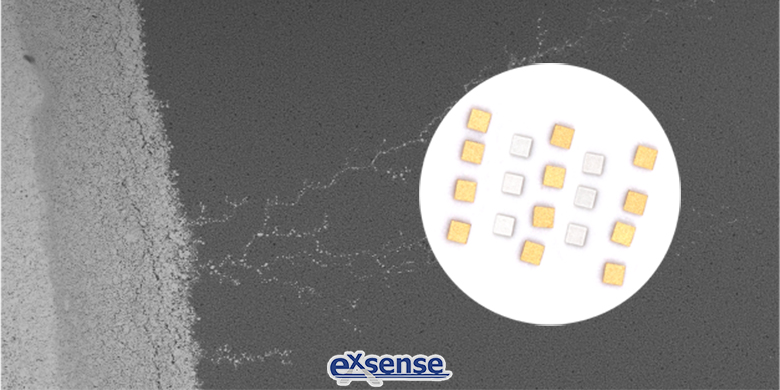
Silver migration refers to the presence of DC voltage gradient in the wet environment, water molecules into the surface of silver-containing conductor electrolysis to form hydrogen ions and hydroxide ions. Under the action of electric field, silver ions migrate from high potential to low potential, and form flocculent or dendritic extension, forming black silver oxide on the boundary where high and low potentials are connected. Silver migration will reduce the reliability of NTC thermistor chip after it is put into use.
The premise of silver migration:
1 .A conductive wet thin film must exist on the surface or inside of the insulating material between the two electrodes;
2. A DC voltage is applied between the two electrodes.
Silver migration is a special phenomenon of electrochemical corrosion, and its mechanism is when a DC voltage is added between the silver electrodes on the insulating substrate (silver-plated pins or silver-plated PCB wiring), when the insulating plate adsorbs moisture or contains halogen elements, etc., the anode is ionized.
Water (H2O) is ionized by electric field:
H2O⇄OH-+H+
H+ moves to the cathode and obtain electron-variable hydrogen gas (H2) from the cathode then releases it to space escape, while OH- moves back to the anode, dissolving the anode silver to form silver hydroxide, its chemical reaction formula:
Ag⇄Ag++e (oxidation reaction)
Ag++OH-⇄AgOH (reduction reaction)
AgOH produced by electrochemical reaction is unstable and easily reacts with oxygen in air or groups in synthetic resins to form silver oxide on the anode side.
2AgOH⇄Ag2O+H2O
If the anode side is continuously dissolved, silver oxide continues to grow until it reaches the cathode, it is reduced from the cathode side and separated out Ag, and the reaction is as follows:
Ag2O+H2O⇄2AgOH⇄2Ag++2OH-
As the above reaction is cyclic, Ag2O continuously grows into dendritically form from anode to cathode, and Ag2O is continuously reduced at the cathode to separated out Ag.
Silver migration occurs not only along the surface of the insulating substrate, but also along the thickness of the substrate. The influencing factors of silver migration are:
First, the state of silver migration varies with the type of decomposition material on the organic insulation board the magnitude of the applied DC voltage, the purity of the water, the temperature of the treatment and humidity, etc.;
Second, the occurrence of silver migration phenomenon is also affected by the existence of some specific ions between the electrodes, such as Cl-, Br-, I-, F- and other halogen ions, the occurrence of silver migration phenomenon will become easier. Organic compounds acting as detergents can also promote migration.
Third, if the ion migration is analyzed from the material, the alloy material is formed after adding other components in the metal like solder, then the formation position, stability and electrode potential and other factors of intermetallic compounds of different metals affect each other, and the causes are more complex.
Fourth, stable compounds (Ag3Sn and CuxSnx) are formed from Ag and Cu which have a faster rate of ion migration. The migration resistance of Sn3.5Ag and Sn0.8Cu unleaded solder alloys is related to the dissolution of Sn. Compared with SnPb solder alloy, the unleaded solder with high Sn has high ion migration resistance because of the stable passive state film formed by Sn. However, the stability of Sn passive state film may be lost due to the influence of environmental conditions.
In order to cope with the phenomenon of silver migration, EXSENSE Electronics Technology Co., Ltd. launched a new product - gold electrode NTC chip. Compared with the silver electrode NTC chip, the gold electrode NTC chip has higher reliability and higher stability.



